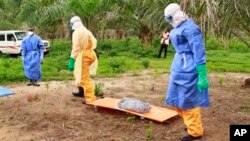The World Bank warns the Ebola deaths of hundreds of healthcare workers could cause maternal mortality rates to soar in Guinea, Liberia and Sierra Leone. The disease has killed health workers at a higher rate than any other population group.
A World Bank report says maternal deaths could reach levels not seen in the Ebola-affected countries in 15 or 20 years. Rates could increase by 38 percent in Guinea, 74 percent in Sierra Leone and 111 percent in Liberia.
Senior Economist and co-author of the report David Evans reacted to those figures.
“What this adds up to is between both mothers and children about 25,000 lost lives per year.”
That could happen, he said, because Ebola has taken such a toll on health workers.
“The Ebola epidemic has had a dramatically disproportionate impact on health workers in these three countries: Sierra Leone, Liberia and Guinea. For example, in Sierra Leone, health workers have been 50 times more likely to contract Ebola than the rest of the population. And the numbers are similar in the other two countries,” he said.
Evans said the three countries were already fragile before Ebola struck because they had “an incredibly limited health care force.”
“Before the Ebola epidemic, Sierra Leone was fifth from the bottom globally in terms of doctors per capita. Liberia was second from the bottom. And Guinea was 28th, which is a little better, but still not a very strong health workforce. So, you start from that and then you take away between five and ten percent of the healthcare workforce,” he said.
Liberia, for example, lost 10 percent of its doctors. It only had 51 prior to the outbreak.
Many have raised concerns that during the Ebola epidemic children did not receive measles vaccinations, malaria and HIV/AIDS patients failed to get treatment and testing for HIV plummeted.
Evans said, “One thing that we noticed is that nobody was really focusing on, specifically, this loss of health workers, which actually has a whole range of effects, including the most fundamental outcomes in the health sector, like maternal and infant mortality.”
But The World Bank report – Healthcare Worker Mortality and the Legacy of the Ebola Epidemic – said all is not lost. Evans said something can be done immediately to keep things from getting worse.
“In the immediate run, we need to make sure that there are plenty of health workers right now that are available. And so one of the solutions to that, which the World Bank and a number of other international partners – the U.N., the African Union – have been supporting [is] the recruitment, training and deployment of foreign health workers to communities in need in Guinea, Liberia and Sierra Leone. So, about 1,300 have been deployed so far. So, in the short run, this is crucial.”
The senior economist said, however, a long-term solution is a necessity.
“It means investing in the local healthcare infrastructure, making sure that doctors, nurses, midwives and community health workers are trained and that they have the protection that they need to do their jobs safely. And that they have the pay that they need so that they’re willing to stay in country. There are a lot of local professionals who want to serve their home population if they can do so in reasonable conditions and with some level of reasonable remuneration,” he said.
The World Bank report said to reach 80 percent health coverage -- included in the Millennium Development Goals --more than 43,000 doctors, nurses and midwives would need to be hired across Guinea, Liberia and Sierra Leone.
The World Bank Study was published in The Lancet Global Health.
















